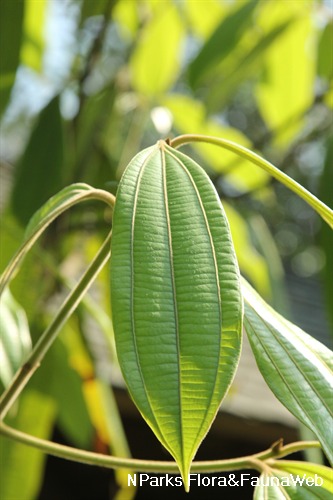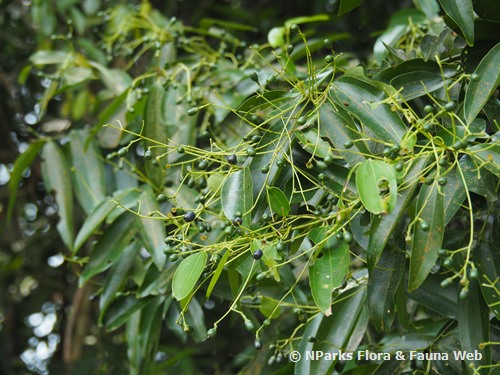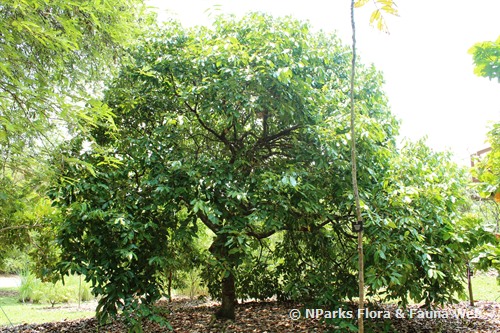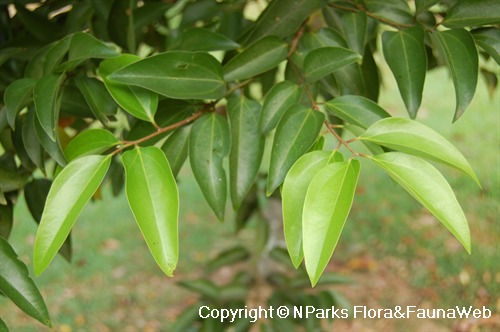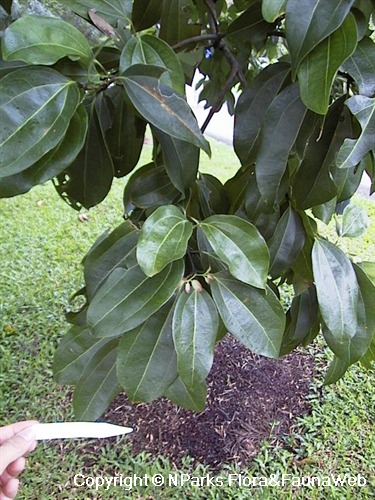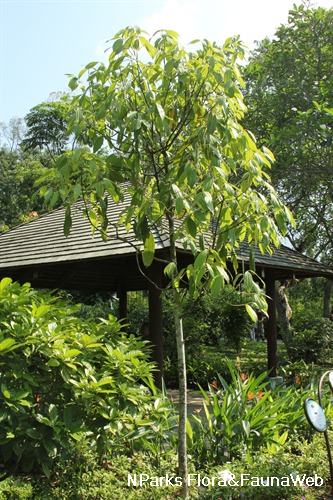
Name
Classifications and Characteristics
| Plant Division | Angiosperms (Flowering Seed Plants) (Dicotyledon) |
|---|---|
| Plant Growth Form | Tree (Medium (16m-30m)) |
| Lifespan (in Singapore) | Perennial |
| Mode of Nutrition | Autotrophic |
| Plant Shape | Irregular |
| Maximum Height | 21 m |
Biogeography
| Native Distribution | South Thailand through Malaysia, Indonesia, the Philippines, Brunei, Singapore to Papua New Guinea |
|---|---|
| Native Habitat | Terrestrial (Primary Rainforest, Secondary Rainforest, Freshwater Swamp Forest) |
| Preferred Climate Zone | Tropical |
| Local Conservation Status | Native to Singapore (Critically Endangered (CR)) |
Description and Ethnobotany
| Growth Form | It is a tree up to 21 m tall. Its twigs, leaves, and flowering shoots are densely velvety. |
|---|---|
| Foliage | Its opposite, stalked leaves have papery or almost leathery leaf blades that are oval or oval-egg-shaped, abruptly tipped, and 11–41 by 4.5–13 cm. The numerous tiny veins perpendicular to the three main veins are highly distinct and the leaf blade between these tiny veins is bulged upwards. The leaves and bark emit a rather sour, resinous scent. |
| Flowers | Its flowering shoots are much-branched, 15–30 by 10–20 cm, and found at the end of leafy twigs. |
| Fruit | Its stalked fruits are oval, up to 1.5 by 1.2 cm, and seated on an inverted cone-shaped or bowl-shaped structure formed by the surviving outer flower parts. |
| Habitat | It grows in lowland and hill forests up to 1400 m altitude. It occurs locally in the vicinity of MacRitchie Reservoir and in Nee Soon Swamp Forest. |
| Associated Fauna | Its flowers are insect-pollinated. |
| Cultivation | It can be propagated by seed. |
| Etymology | Greek Cinnamomum, referring to the name for cinnamon; Latin javanicus, of Java, referring to one locality in the natural distribution of this species |
| Ethnobotanical Uses | Others: The plant has horticultural potential for its beautiful growth form and distinctive leaves. The bark is suggested to be a source of aromatic bark. The leaves and roots are used medicinally. |
Landscaping Features
| Landscaping | It may be suitable for parks. |
|---|---|
| Desirable Plant Features | Ornamental Foliage, Ornamental Form |
| Landscape Uses | General, Parks & Gardens, Small Gardens |
Fauna, Pollination and Dispersal
| Pollination Method(s) | Biotic (Fauna) |
|---|---|
| Seed or Spore Dispersal | Biotic (Fauna) |
Plant Care and Propagation
| Light Preference | Full Sun, Semi-Shade |
|---|---|
| Water Preference | Moderate Water |
| Plant Growth Rate | Moderate |
| Rootzone Tolerance | Moist Soils, Well-Drained Soils, Fertile Loamy Soils |
| Propagation Method | Seed |
Foliar
| Foliage Retention | Evergreen |
|---|---|
| Mature Foliage Colour(s) | Green |
| Mature Foliage Texture(s) | Papery, Leathery |
| Foliar Type | Simple / Unifoliate |
| Foliar Arrangement Along Stem | Opposite |
| Foliar Attachment to Stem | Petiolate |
| Foliar Shape(s) | Non-Palm Foliage (Ovate, Oval, Elliptical) |
| Foliar Venation | Pinnate / Net |
| Foliar Margin | Entire |
Floral (Angiosperm)
| Flower & Plant Sexuality | Bisexual Flowers |
| Flower Grouping | Cluster / Inflorescence |
|---|---|
| Flower Location | Axillary |
Fruit, Seed and Spore
| Fruit Classification | Simple Fruit |
|---|---|
| Fruit Type | Fleshy Fruit , Non-Accessory Fruit |
Image Repository
Others
| Master ID | 29508 |
|---|---|
| Species ID | 3817 |
| Flora Disclaimer | The information in this website has been compiled from reliable sources, such as reference works on medicinal plants. It is not a substitute for medical advice or treatment and NParks does not purport to provide any medical advice. Readers should always consult his/her physician before using or consuming a plant for medicinal purposes. |

